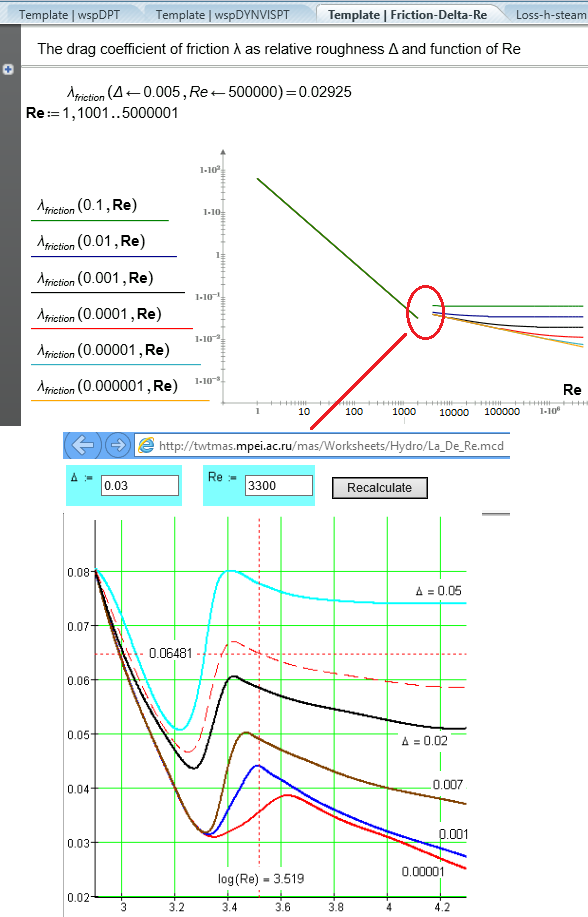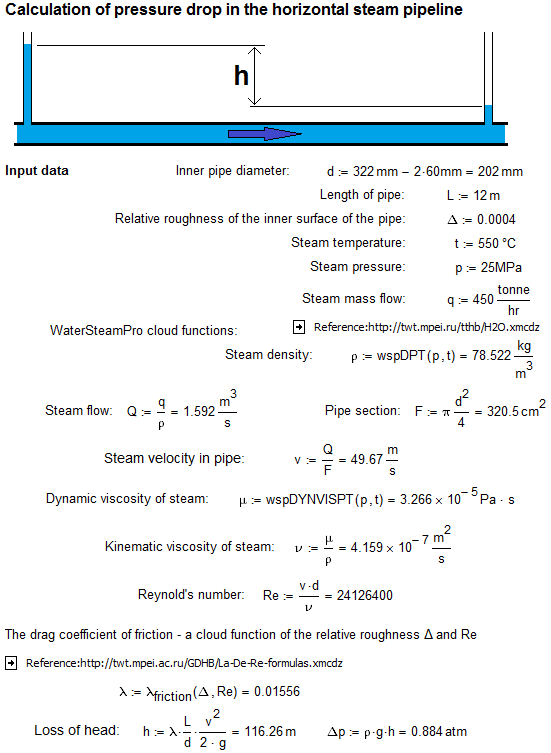- Subscribe to RSS Feed
- Mark Topic as New
- Mark Topic as Read
- Float this Topic for Current User
- Bookmark
- Subscribe
- Mute
- Printer Friendly Page
A calculation of steam fluid flow pressure loss
- Mark as New
- Bookmark
- Subscribe
- Mute
- Subscribe to RSS Feed
- Permalink
- Notify Moderator
A calculation of steam fluid flow pressure loss
Attached is a steam flow pressure loss calculation.
I broke it down into three file. Please make sure your mathcad has internet access because
Thermodynamic Properties of steam flow is based on IAPWS-97 mathcad server . I really appreciate the authors effort
You probably has to rework the file reference in the "steam head loss PartIII " to point to the other file
the reference of viscousity calculation can be found in the mathcad file
The fanning friction factor is simply a find(f) of the colebrook-white equation thanks to the power of mathcad, dont we all love that?.
I would like the community effort to check the validity of the calculation (I only check a few result and it seems to be matching table/graph value of steam pressure loss)
You can go to "steam head loss Part III" to change the pressure, temperature and piping data. Feedbacks are most welcomed!
The file only works in (and hopefully it works):
0<T<800C, P<100MPa and 800<T<2000C, P<50MPa because that's the range of IAPWS-97
Thanks
BTW, I am struggling with my career and if anyone is interested in hearing me whining please send me a private message.
Solved! Go to Solution.
- Labels:
-
Statistics_Analysis
Accepted Solutions
- Mark as New
- Bookmark
- Subscribe
- Mute
- Subscribe to RSS Feed
- Permalink
- Notify Moderator
- Mark as New
- Bookmark
- Subscribe
- Mute
- Subscribe to RSS Feed
- Permalink
- Notify Moderator
See here please http://www.iapws.org/relguide/viscosity.htm
Matcad on-line calcularion
- Mark as New
- Bookmark
- Subscribe
- Mute
- Subscribe to RSS Feed
- Permalink
- Notify Moderator
Special for You I add the wspDYNVISPT function in my WaterSteamPro cloud function set:
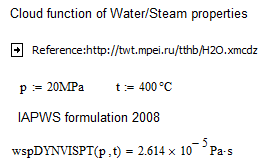
- Mark as New
- Bookmark
- Subscribe
- Mute
- Subscribe to RSS Feed
- Permalink
- Notify Moderator
- Mark as New
- Bookmark
- Subscribe
- Mute
- Subscribe to RSS Feed
- Permalink
- Notify Moderator
Wow did not know this exited on your website, thanks!
let me compare the result.
- Mark as New
- Bookmark
- Subscribe
- Mute
- Subscribe to RSS Feed
- Permalink
- Notify Moderator
henry leung wrote:
Wow did not know this exited on your website, thanks!
And where did you find out about these resources?
- Mark as New
- Bookmark
- Subscribe
- Mute
- Subscribe to RSS Feed
- Permalink
- Notify Moderator
WHat "resources" do you mean? IAPWS? I learn about IAPWS through this community and the almighty power of google! There is almost nothing that you cannot find on google
- Mark as New
- Bookmark
- Subscribe
- Mute
- Subscribe to RSS Feed
- Permalink
- Notify Moderator
But in Russian Google:

- Mark as New
- Bookmark
- Subscribe
- Mute
- Subscribe to RSS Feed
- Permalink
- Notify Moderator
Mathcad 3.0 is released?
Unfortunately the USA google cannot find the mathcad server by "Calculation in Internet"
If I search "mathcad calculation server" in USA then I can find a ptc community discussion, from which I can find a link to your server.
But thanks to the almighty google translator I can understand Russian on your server now!
- Mark as New
- Bookmark
- Subscribe
- Mute
- Subscribe to RSS Feed
- Permalink
- Notify Moderator
I have an english version of MCS:
http://twt.mpei.ac.ru/ochkov/VPU_Book_New/mas/eng/index.html
- Mark as New
- Bookmark
- Subscribe
- Mute
- Subscribe to RSS Feed
- Permalink
- Notify Moderator
henry leung wrote:
Mathcad 3.0 is released?
Not yet. We will get it in sommer. I hope. I wort with beta-version.
- Mark as New
- Bookmark
- Subscribe
- Mute
- Subscribe to RSS Feed
- Permalink
- Notify Moderator
Solution with templates of Mathcad Prime 3.0. See the discription in attach.
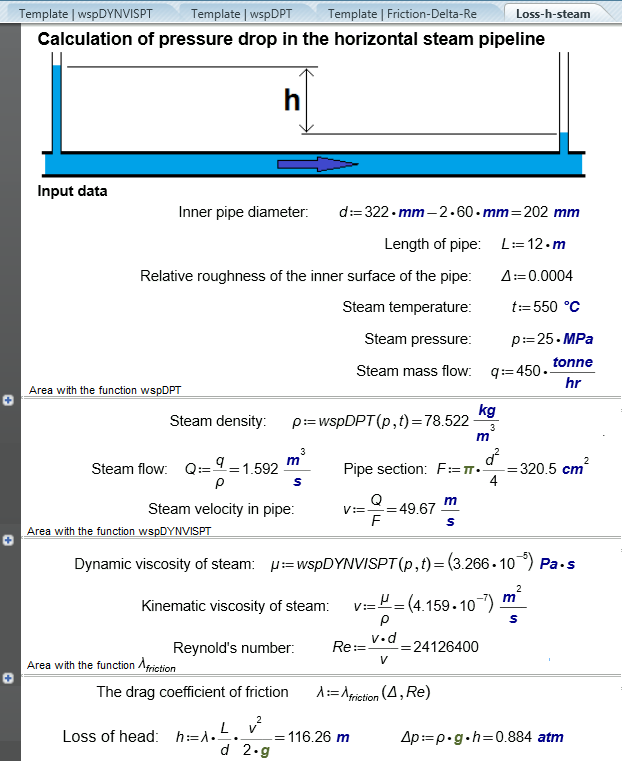
- Mark as New
- Bookmark
- Subscribe
- Mute
- Subscribe to RSS Feed
- Permalink
- Notify Moderator
There is a lot of formulas for this function...
But what is it delta!? How can we messure it!?
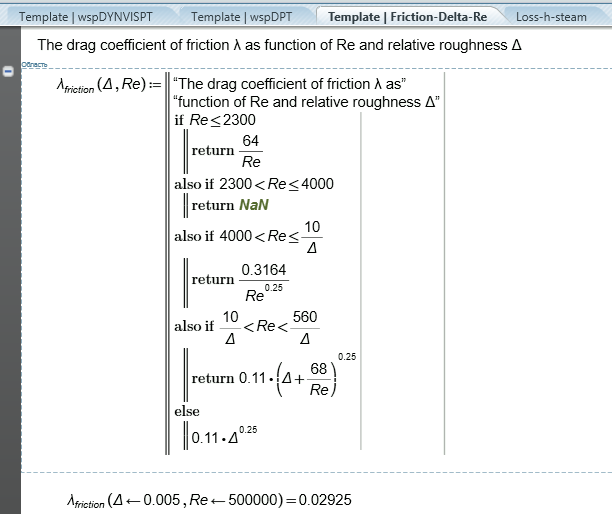
- Mark as New
- Bookmark
- Subscribe
- Mute
- Subscribe to RSS Feed
- Permalink
- Notify Moderator
Actually I do not know ! There are tabulated value of absolute roughness of different piping material of NEW pipe...as the pipe ages/corrode/get deposite etc. ...then of course its roughness changes
I think you can do experiment to re-measure the roughness. But since we can only measure pressure drop as far as I know....it is like collecting pressure drop data and fitting a "rougness" parameter for what ever function you use to model pressure drop.
But maybe there are special way to actually measure "roughness"? Hope some industry professional can address your question. Besides, how much attention does the industry pay to the absolute roughness of aging pipe? Or they just pay attention to the pressure drop since this is the ultimate properties that impact $$$$$$?
- Mark as New
- Bookmark
- Subscribe
- Mute
- Subscribe to RSS Feed
- Permalink
- Notify Moderator
Yeeeeeeeeeeeeeeees!
But we need (have) to design pipelines - someone is better then nothing!
See too
Mathcad 11 Server http://twtmas.mpei.ac.ru/mas/Worksheets/Hydro/La_De_Re.mcd
Mathcad 14 Server http://twt.mpei.ac.ru/MCS/Worksheets/Hydro/La-De-Re.xmcd
It is the region NaN on the function Lambda.friction(Delta, Re) - see above the template Friction-Delta-Re
- Mark as New
- Bookmark
- Subscribe
- Mute
- Subscribe to RSS Feed
- Permalink
- Notify Moderator
Nikuradze spoons:
